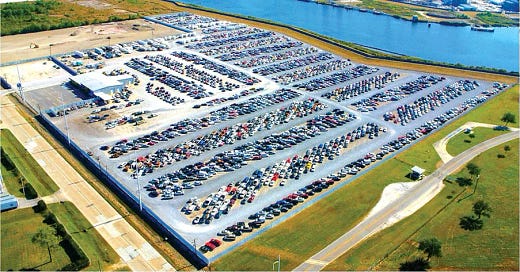Copart, Inc. - June 6, 2024 - Baird 2024 Global Consumer, Technology & Services Conference
Transcript Notes
COPART, INC. - June 6, 2024
Pandemic Effect on Total Loss Rates and Implications
Pandemic Impact:
Reduced unit production and repair shop availability.
Decreased accident frequency due to reduced driving.
Total loss frequency declined for the first time.
the insurance company's decision to deem a vehicle a total loss comes down to two key variables that they consider. First is the value of that vehicle, the moment before it got into the accident and the cost to repair, net of what they would achieve at auction.
Post-Pandemic:
Total loss rates returned to near pre-COVID levels.
Increased vehicle availability led to stabilized used car prices.
Insurance companies adjusted total loss thresholds based on normalized vehicle values.
Implications:
Increased total loss rates negatively impact the business.
Increase in Total Loss Rates Hasn’t Impacted Average Selling Price (ASP)
Higher Value Vehicles in Total Loss: As total loss rates increase, more higher-value vehicles are being totalled due to repair costs exceeding salvage value.
ASP Floor: The inclusion of these higher-value vehicles in the total loss pool creates a floor for ASP, preventing it from declining.
ASP Increase: As more lighter damage (and inherently higher value) vehicles enter the mix, ASP is actually increasing.
ADAS & EV Trends
ADAS Impact
Increased accident severity:
While ADAS reduces accident frequency, it leads to higher repair costs due to expensive components and labor.
Higher total loss rates: The increased cost of repairs makes vehicles more likely to be totalled.
EV Impact
Similar to ADAS: EVs often have many ADAS components, contributing to higher repair costs and total loss rates.
Battery value: Intact batteries significantly increase the value of EVs, influencing salvage values.
Overall Trend
Vehicle complexity: The number of parts and repair time has increased by 50% and 25% respectively in the last decade.
Rising costs: Increased complexity drives up repair costs and impacts the overall business positively for Copart.
Land Acquisition and Utilization
Key Drivers for Land Investment:
Capacity: Anticipating future growth in total loss frequency and corresponding storage needs. Planning for decades in the future.
Cost efficiency: Optimizing logistics network through increased node density. The increased frequency of those nodes reduces your cost for transport.
Catastrophic events: Securing land in disaster-prone areas for emergency storage. There are parts of the country (U.S.) that are acutely prone to catastrophic events. Copart has thousands of acres of stores dedicated for those events. And those tend to be in areas where they can get hundreds of acres dedicated. And this land is not easy to permit.
Land Acquisition Strategy:
Long-term planning: Forecasting land requirements based on market analysis and carrier trends.
Strategic location: Identifying areas with high growth potential and cost-effective transportation options.
Risk mitigation: Protecting land entitlements to ensure long-term use for storage purposes.
Land as a Competitive Advantage:
Market leadership: Copart's extensive land portfolio is a significant barrier to entry for competitors. Once you have entitlements, many of these entitlements are grandfathered in.
Industry stewardship: Maintaining land for storage purposes benefits the entire industry.
Operational efficiency: Optimized land utilization improves cost structure and operational performance.
Lag effect on ROIC: Land acquisition strategy will initially have the effect of lowering ROIC until it is utilized fully in the future as Copart grows.
Insurance Customer Pain Points and Solutions
Primary Pain Point: Managing costs within claims organizations.
Key Issues:
Lengthy cycle times resulting in increased storage costs. Insurers have significant advanced charges that they accrue on these vehicles. So if it takes multiple days for a vehicle to get to a preferred shop, all of that storage is accruing and ultimately is waste.
Lack of data-driven decision making in claims process.
Copart's Solution:
Accelerate vehicle movement to reduce storage costs.
Provide data analytics to optimize claims processes.
Offer benchmarking and best practices to improve overall performance.
Collaborate with insurers to identify and address process inefficiencies.
Overall Goal: Help insurers reduce costs and increase profitability through efficient claims management.
How ‘Sticky’ is Copart's Business insurance companies?
Copart views its relationship with insurance companies as dynamic, not static.
While long-term contracts exist, Copart maintains a proactive approach to customer retention.
Focus on understanding and addressing customer needs to maintain and grow market share.
Copart believes its strong customer relationships are a key factor in its market position.
Growth Opportunities Outside of the Insurance Sector
Blue Car Segment (finance, rental, fleet):
Significant growth potential due to unique needs of these customers.
Copart's existing infrastructure (real estate, logistics, technology) can address customer challenges.
Examples of solutions: efficient vehicle extraction for finance companies, storage solutions for rental companies.
the financial decision around whether or not they repair that car is very different than an insurance carriers because they're losing revenue every day that the car is not getting repaired.
rental car companies since they self-insure are "totalling vehicles" at a much higher total loss -- equivalent total loss frequency. And those vehicles are getting good liquidity and demand at Copart auctions.
Focus on Lighter Damage Vehicles:
Expanding into higher-value, less damaged vehicles.
New leadership team dedicated to this growth area.
Overall Goal:
Increase market share in the non-insurance sector.
Develop tailored solutions for different customer segments.
Purple Wave Investment
Strategic Alignment: Copart has a history of successful acquisitions (e.g., NPA for Powersports). Purple Wave aligns with this strategy.
Investment Structure: Copart acquired an 80% stake in Purple Wave with a path to full ownership. The founders retain significant ownership to maintain alignment.
Growth Strategy: Purple Wave will expand its operations nationwide, leveraging Copart's brand, resources, and operational capabilities.
Focus Areas: Expanding the sales force and optimizing operational integration to drive growth. 100% focused on growth.
Long-Term Vision: Copart aims to transform Purple Wave from a Midwest-focused business into a national leader in specialty equipment auctions.
Competitive Landscape & Re-Marketing Options
Traditional Method: On-premise auctions, typically held infrequently (quarterly).
typically heavy equipment, agricultural machinery type units have been sold through on-prem options
Shifting Trend: Move towards off-premise, higher frequency auctions due to:
Rapid depreciation of equipment
High transportation costs
Competitive Advantage: Copart's off-premise model offers cost savings for sellers.
Alternative Channels: Large fleet companies can sell directly, but this is less common due to industry practices and buyer preferences.
Market Opportunity: Strong demand for used specialty equipment creates a large potential market for Copart.
the industries around specialty equipment are conditioned to buy and sell used equipment quite frequently. And so there's a high level of turnover. And so that's what Copart is excited about because there's a nice pocket of addressable market for them to go after.
Can Purple Wave's Operations Leverage Copart Land Assets?
While it's possible to use Copart's land for Purple Wave's operations, it's not the primary focus.
The core strength of Purple Wave is its off-premise, pure-sale auction model.
This model drives high buyer activity and better returns for sellers.
Copart's primary goal is to expand Purple Wave's reach and replicate its success nationwide.
Land-based storage might be considered for specific, large-scale sellers in certain markets.
Purple Wave Total Addressable Market
The market for specialty equipment is highly fragmented.
Copart can leverage existing relationships with fleet companies and dealers.
Building a strong sales team is crucial to expanding market reach.
This investment is similar to previous successful acquisitions (NPA and Powersports) in diversifying Copart's offerings.
The goal is to complement the existing salvage and specialty business.
Summary of New Executive Roles
Dave Kang, Chief Marketing Officer:
Focus on expanding the buyer base, particularly for wholesale units.
Building brand awareness and customer acquisition.
Neel Madhvani, Chief Product Officer:
Improving the customer experience for different buyer types (dismantlers, dealers, consumers).
Developing new products and enhancing the online platform.
Hessel Verhage, Chief Operating Officer:
Optimizing logistics and operations for increased efficiency.
Improving overall operational scale and performance.
Summary of Copart's International Strategy
Focus on Germany: Copart is optimizing operations and expanding revenue streams in Germany.
Strong Performance in UK: Copart has gained market share in the UK and is investing in infrastructure (land) to support growth.
Diversification: Copart operates in 11 markets globally to diversify revenue.
Target Markets: High GDP per capita countries with strong OEM presence are attractive for growth.
Growth Strategy: Copart will explore both organic and inorganic growth opportunities in international markets.
Summary of Copart's Capital Allocation Plans
Strong Balance Sheet: Copart holds over $3 billion in cash and no debt. Over $4 billion of liquidity.
Long-Term Investment Horizon: The company takes a patient approach to capital allocation, focusing on long-term returns. Investment horizon is 10, 20, 30 years.
Investment Priorities:
Expanding capabilities, real estate, and technology.
Active M&A to accelerate growth and enhance capabilities.
Share repurchases as a potential option.
Risk Management: Copart maintains a fortress-like balance sheet by investing in U.S. Treasuries.
Overall Strategy: A disciplined approach to capital allocation with a focus on maximizing long-term shareholder value.
ROIC is lower on the above calculation due to the increased cash and short-term bonds on the balance sheet earning interest. If normalizing this for the cash needed to run the business ROIC & ROIIC is much higher.








